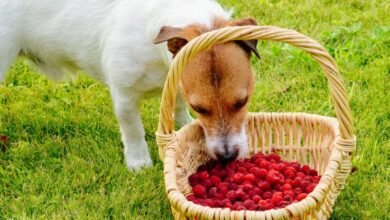
Can Dogs Eat Garlic? It’s important to know that garlic is harmful to dogs. It contains thiosulfates, compounds that can be toxic to your furry friend. These thiosulfates can cause oxidative damage to red blood cells, leading to a serious condition called hemolytic anemia.
Unlike humans, dogs process garlic differently due to their unique metabolism. Even small amounts can lead to health issues, so it’s best to keep garlic away from your pet’s diet. Understanding these risks helps ensure your dog stays happy and healthy. Let’s explore how can dogs eat garlic.
The Science Behind Garlic Toxicity
Can Dogs Eat Garlic? Understanding the science behind garlic toxicity is crucial for dog owners who want to keep their pets safe. Garlic contains compounds that can interfere with the normal functioning of your dog’s red blood cells, leading to serious health issues.
Thiosulfates Interfere with Red Blood Cells
- Toxic Compound: Garlic contains thiosulfates, which are the primary toxins that pose a danger to dogs. Unlike humans, dogs lack the enzymes needed to break down these compounds, making them particularly vulnerable.
- Disruption of Function: Thiosulfates interfere with the red blood cells’ ability to function properly. Specifically, they can cause oxidative damage, which affects the cells’ integrity and efficiency.
Reduction in Oxygen-Carrying Capacity
- Oxygen Transport: Normally, red blood cells carry oxygen throughout the body, supplying essential organs and tissues. When thiosulfates damage these cells, their ability to transport oxygen is compromised.
- Health Impact: As a result, your dog may experience a lack of oxygen in their body, leading to various symptoms, particularly those associated with anemia.
Symptoms of Anemia and Other Health Issues
- Anemia: The primary health issue resulting from garlic toxicity is anemia, a condition where the blood lacks enough healthy red blood cells. Symptoms can include lethargy, weakness, and pale gums.
- Other Complications: In severe cases, garlic toxicity can lead to more serious complications, including organ damage and a weakened immune system. This underscores the importance of keeping garlic and garlic-containing foods away from your dog.
Understanding the science behind garlic toxicity highlights why even small amounts of garlic can be dangerous for dogs. Being aware of the risks and taking precautions can help you protect your dog from the harmful effects of garlic.
Symptoms of Garlic Poisoning
Can Dogs Eat Garlic? Garlic poisoning in dogs can manifest in various symptoms, ranging from mild to severe. Recognizing these symptoms early is crucial for getting your dog the help they need and preventing long-term health issues.
Mild Symptoms: Gastrointestinal Upset
- Vomiting: One of the first signs of garlic poisoning is vomiting. If your dog has ingested garlic, you might notice them regurgitating their food shortly afterward.
- Diarrhea: Along with vomiting, diarrhea is a common symptom. This gastrointestinal upset can lead to dehydration if not addressed promptly.
- Abdominal Pain: Your dog may also show signs of discomfort or pain in the abdomen, often expressed through whining, restlessness, or reluctance to move.
Severe Symptoms: Lethargy and Weakness
- Lethargy: As garlic toxicity progresses, your dog may become unusually tired or weak. They might be less interested in activities they normally enjoy and may sleep more than usual.
- Weakness: Alongside lethargy, you may notice a general weakness, where your dog struggles to stand, walk, or engage in physical activities.
- Pale Gums: Check your dog’s gums for a pale color, which can indicate anemia—a lack of healthy red blood cells. This is a serious symptom that requires immediate veterinary attention.
- Rapid Breathing: Rapid or labored breathing is another severe symptom, reflecting the body’s struggle to transport enough oxygen due to the compromised red blood cells.
Long-Term Effects: Chronic Anemia and Health Problems
- Chronic Anemia: If garlic poisoning is not treated promptly, it can lead to chronic anemia. This condition weakens your dog over time, affecting their overall quality of life and making them more susceptible to other illnesses.
- Organ Damage: Prolonged exposure to garlic can strain your dog’s liver and kidneys, leading to potential organ damage. This is particularly concerning if your dog has ingested garlic repeatedly over time.
- Weakened Immune System: The ongoing effects of garlic toxicity can also compromise your dog’s immune system, making them more vulnerable to infections and other health issues.
Recognizing the symptoms of garlic poisoning and acting quickly is vital in preventing these mild to severe effects from escalating. If you suspect your dog has consumed garlic, contacting your vet immediately is the best course of action.
How Much Garlic Can Cause Harm?
Can Dogs Eat Garlic? Understanding the potential harm garlic can cause to dogs is crucial for pet owners. Garlic toxicity in dogs is influenced by several factors, including the size, breed, and overall health of the dog. Since there isn’t a well-defined safe threshold, even small amounts can pose a risk, particularly with repeated exposure.
Toxicity Levels Vary with the Dog’s Size, Breed, and Overall Health
- Size Matters: Smaller dogs are generally more susceptible to garlic toxicity than larger dogs. The smaller the dog, the less garlic it takes to cause harm.
- Breed Sensitivity: Certain breeds may be more sensitive to garlic due to genetic factors or predispositions. For example, breeds with already existing health issues or those prone to anemia might react more severely.
- Health Condition: A dog’s overall health also plays a role in how their body handles garlic. Dogs with pre-existing health conditions, especially related to the liver or red blood cells, are at a higher risk.
Even Small Amounts Can Be Harmful, Especially with Repeated Exposure
- Cumulative Effect: While a single small amount of garlic might not immediately cause visible symptoms, repeated exposure can lead to a cumulative effect, increasing the risk of toxicity over time.
- No Safe Exposure: Even what might seem like an insignificant amount can cause harm, especially if garlic is consumed regularly. Pet owners should be cautious about any garlic in their dog’s diet.
A Safe Threshold Is Not Well-Defined, Making Any Garlic Potentially Risky
- Lack of a Clear Threshold: Unlike some other foods, where safe amounts can be measured, garlic does not have a well-defined safe threshold for dogs. This uncertainty makes it challenging to determine how much is too much.
- Potentially Risky: Because there is no universally agreed-upon safe amount, it’s best to consider any garlic consumption as potentially harmful. Avoiding garlic entirely is the safest approach to prevent accidental poisoning.
Given the variability in how different dogs may react to garlic, it’s important to err on the side of caution. To protect your dog’s health, it’s best to avoid feeding them garlic in any form and be vigilant about the ingredients in their food and treats.
What to Do If Your Dog Ingests Garlic
Can Dogs Eat Garlic? If your dog accidentally ingests garlic, it’s important to act quickly. Garlic can be harmful to dogs, and prompt action can make a significant difference in preventing serious health issues.
Contact a Veterinarian Immediately for Advice
- Urgency Is Key: The first thing you should do is contact your veterinarian right away. Time is of the essence, and a vet can provide immediate guidance on the best course of action based on your dog’s situation.
- Emergency Hotlines: If you can’t reach your regular vet, consider contacting an emergency animal hospital or a pet poison control hotline. They can offer critical advice in real-time.
Provide Details About the Quantity and Type of Garlic Consumed
- Be Specific: When speaking with the vet, provide as much information as possible about the garlic your dog consumed. Mention whether it was raw, cooked, or part of a processed food.
- Estimate the Amount: Try to estimate how much garlic your dog ate. Even small amounts can be significant, so give the best estimate you can to help the vet assess the situation accurately.
Follow Professional Guidance, Which May Include Inducing Vomiting or Other Treatments
- Veterinary Instructions: Based on the information you provide, the vet may instruct you to bring your dog in for immediate treatment. Alternatively, they might guide you through first aid steps at home, such as inducing vomiting to expel the garlic.
- Possible Treatments: The vet may recommend treatments like activated charcoal to prevent further absorption of toxins or IV fluids to support your dog’s system. Follow all instructions carefully to ensure your dog receives the best care possible.
- Ongoing Monitoring: After the initial treatment, continue to monitor your dog closely for any signs of garlic toxicity. Follow up with your vet as needed to ensure your dog recovers fully.
If your dog eats garlic, swift action is crucial. Always keep the number of your veterinarian or an emergency animal hospital handy, and don’t hesitate to seek help immediately.
Alternatives to Garlic in Your Dog’s Diet
Can Dogs Eat Garlic? While garlic is not safe for dogs, there are plenty of alternatives that can add flavor and nutrition to your dog’s diet without risking their health. It’s important to explore these options to ensure your pet’s meals are both tasty and safe.
Use Dog-Safe Flavor Enhancers Like Pumpkin or Sweet Potatoes
- Pumpkin: Pumpkin is not only safe for dogs but also highly nutritious. It’s rich in fiber, which aids digestion, and can be easily mixed into your dog’s food to add a touch of sweetness and flavor.
- Sweet Potatoes: Sweet potatoes are another great alternative. They are packed with vitamins and minerals, and their natural sweetness can make your dog’s meals more enjoyable. You can steam or bake them and then mash or chop them into small pieces.
- Other Vegetables: Carrots and green beans are also excellent choices. These veggies are safe, low in calories, and full of vitamins, making them perfect for flavoring your dog’s food.
Opt for Commercially Prepared Dog Foods That Are Free from Harmful Ingredients
- Read Labels Carefully: When choosing dog food, always check the ingredients list to ensure it doesn’t contain garlic or other harmful additives. Many high-quality commercial dog foods are specifically formulated to be safe and nutritious.
- Natural Ingredients: Look for dog foods that use natural, wholesome ingredients without unnecessary fillers or artificial preservatives. Brands that focus on real meat, vegetables, and grains are generally safer and healthier.
- Specialty Diets: If your dog has specific dietary needs or preferences, consider foods designed for those conditions. For example, there are grain-free, limited-ingredient, and hypoallergenic options available.
Consult with a Vet for Safe Ways to Add Flavor or Nutrition to Your Dog’s Diet
- Professional Advice: Your veterinarian can provide tailored recommendations for your dog’s diet, ensuring that any additions are safe and beneficial. Whether you’re looking to enhance flavor or boost nutrition, a vet’s guidance is invaluable.
- Supplements: There are dog-safe supplements available that can enhance your pet’s diet. Omega-3 fatty acids, for example, can support healthy skin and coat, while glucosamine can aid in joint health. Always consult your vet before adding any new supplements.
- Homemade Diets: If you prefer to prepare homemade meals for your dog, your vet can help you design a balanced and nutritious diet plan that meets all of your dog’s needs without the risk of toxic ingredients like garlic.
By choosing safe and nutritious alternatives to garlic, you can keep your dog’s meals both flavorful and healthy. Always prioritize your pet’s well-being by selecting ingredients that support their health, and consult with a vet to ensure you’re providing the best possible diet.




